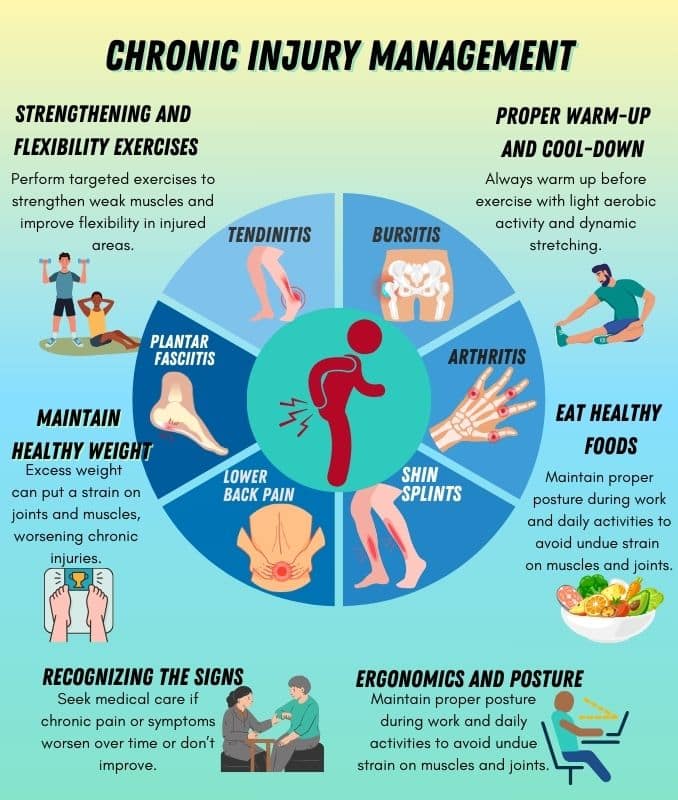Are you living with the long-term pain of an old injury? I know how it feels to struggle with persistent discomfort that seems to linger forever, even after months of hoping for relief. Chronic injury can be overwhelming, robbing you of the freedom to move and enjoy everyday activities.
I remember when I first encountered the difference between chronic and acute injuries. Acute injuries, like the sprained ankle I suffered in 10th grade playing basketball, hit all at once. However, chronic injuries are sneaky; they build up over time and can stem from overuse, repetitive strain, or improper healing. I’ve seen firsthand how they develop gradually, becoming stubborn and resistant to quick fixes or even rest.
Through my journey in recovery and rehabilitation, I learned that managing chronic injuries requires a tailored approach. It's not just about masking the symptoms but addressing the underlying causes. This understanding has shaped my mission to help others navigate the complexities of healing.
In this guide, I want to share with you practical strategies and expert advice that I've gathered over the years. Together, we can explore valuable solutions to support your long-term health and well-being.
Understanding Chronic Injuries

What Is A Chronic Injury?
Chronic injuries differ from acute injuries, which happen suddenly, like a sprained ankle or a broken bone. Acute injuries happen suddenly, often due to trauma during physical activity. On the other hand, chronic injuries develop gradually over time and persist for more than 12 weeks or keep coming back. These injuries often result from overuse or improper healing after an acute injury.
Both acute and chronic injuries require care, but chronic injuries can be especially tricky because they don’t heal as quickly and may require long-term management.
Common Types Of Chronic Injuries
Here are some examples of chronic injuries and their symptoms:
- Tendonitis: A common overuse injury where tendons become inflamed due to repetitive motions. Symptoms include pain, swelling, and stiffness around the joint.
- Arthritis: A chronic condition that causes joint inflammation, stiffness, and pain, often affecting older adults but also athletes who experience repeated joint stress.
- Lower Back Pain: Often caused by poor posture, muscle strain, or disk issues, low back pain [¹] can persist if not properly treated.
- Shin Splints: A type of stress fracture that occurs along the shinbone, often caused by repetitive impact, common among runners.
- Plantar Fasciitis: Chronic heel pain resulting from inflammation of the tissue on the bottom of the foot, especially common in runners and people on their feet for long periods.
Why Chronic Injuries Persist
Both acute and chronic sports injuries can persist if not managed properly, but chronic injuries are especially prone to lingering. Some reasons include:
- Improper Treatment Of Acute Sports Injuries: When an acute sports injury isn't treated right from the start, it may lead to long-term damage or chronic injuries.
- Overuse: Continuing physical activities without giving the body enough time to heal leads to overuse injuries, which can transition into chronic conditions.
- Lack Of Physical Therapy: Many people skip or cut short their physical therapy after an injury, missing out on proper rehabilitation. This can lead to long-term issues.
- Ignoring Symptoms: Pushing through pain can worsen both acute and chronic injuries, making them harder to treat in the long run.
Understanding the differences between acute and chronic injuries is key to ensuring proper care and preventing them from turning into long-term problems.
Long-Term Strategies For Managing Chronic Injuries

As someone who has navigated the complexities of chronic injury, I understand that managing pain requires a holistic approach that encompasses both physical health and mental wellness. By prioritizing these elements, you can create a sustainable path toward recovery and regain control over your life.
Let’s begin with the first strategy:
1. Adopt A Holistic Approach
Prioritize both your physical health and mental wellness to achieve long-term success in managing either acute or chronic injuries:
- Balance Your Health: Include activities that nurture both your body and mind.
- Manage Stress: Incorporate mindfulness practices such as meditation or deep breathing to lower stress levels.
Dr. Howard Schubiner, an internal medicine specialist, emphasizes that meditation is a transformative tool for managing chronic pain. Dr. Schubiner says, “It's important not just to meditate but to understand how to use it as a tool to help reverse pain rather than merely cope with it.”
- Take care of overall well-being: Get enough sleep, manage emotions, and maintain a positive mindset, as these factors play a crucial role in recovery.
2. Strengthening And Flexibility Exercises
Consistent, targeted exercise is essential for supporting injured areas and preventing further complications:
- Target Weak Muscles: Focus on exercises that strengthen muscles around the injury to build support.
- Improve Flexibility: Stretch and incorporate low-impact exercises such as yoga, Pilates, swimming, or dedicated flexibility routines.
“Yoga is beautiful because it combines calming reassurance and joy with movement. When you move in fear, you reinforce the pain-fear-pain neural circuits. However, by moving gently with calm, joy, or control, you teach your brain that these movements are safe, helping to rewire those neural connections.”- Dr. Howard Schubiner, Internal Medicine Specialist
- Prioritize Mobility: Regularly perform mobility exercises to maintain joint health and reduce the risk of aggravating injuries.
3. Maintain A Healthy Weight
Carrying excess weight can increase strain on your joints and muscles, which may worsen chronic conditions. Here’s how you can manage your weight safely:
- Eat A Balanced Diet: Incorporate whole foods, lean proteins, and healthy fats to support healing and weight maintenance.
- Stay Active: Choose low-impact physical activities such as walking, cycling, or swimming that are safe for your condition.
- Consult A Professional: Reach out to a nutritionist or dietitian for personalized dietary guidance tailored to your specific needs.
4. Know When To Seek Medical Help
It’s crucial to recognize when professional intervention is necessary:
- Understand The Warning Signs: Seek medical advice if your symptoms worsen or if you experience swelling, loss of function, or sharp, persistent pain.
- Explore Advanced Treatment Options: For severe cases, options like surgery, regenerative medicine (e.g., platelet-rich plasma or stem cell therapy), or new techniques such as shockwave or laser therapy may aid recovery.
5. Work With Healthcare Providers
Collaboration with healthcare professionals can be key in creating an effective long-term management plan:
- Schedule Regular Check-Ups: Regular visits to your physician, physical therapist, or specialist ensure you’re on the right track.
- Develop A Personalized Treatment Plan: Work with your healthcare team to create a sustainable plan for long-term management and optimal recovery.
6. Prevent Future Injuries
Prevention plays a vital role in managing chronic conditions:
- Warm-Up And Cool Down: Always start the exercise with light aerobic activity and dynamic stretches to prepare your body, and finish with static stretches to improve flexibility and reduce stiffness.
- Focus On Ergonomics And Posture: Whether at work or home, ensure that your environment supports good posture. Ergonomic adjustments like using a supportive chair or proper desk setup can reduce strain [²] on muscles and joints.
- Build Physical And Mental Resilience: Regularly engage in strength training and flexibility exercises to reduce injury risk. Equally, cultivate mental resilience by maintaining a positive mindset and using stress-relief techniques. Consider working with a physical therapist for a comprehensive injury prevention plan.
Conclusion
Managing chronic and acute injuries requires a thoughtful combination of rest, rehabilitation, and long-term care. For chronic injury such as tendinitis or joint degeneration, long-term management often includes physical therapy, anti-inflammatory strategies, and lifestyle adjustments. For conditions like stress fractures or recurring pain from previous injuries, strengthening exercises, flexibility training, and maintaining a healthy weight are crucial.
Be it dealing with chronic injury or recovering from acute sports injuries, a balanced and mindful approach ensures better outcomes. Moreover, it’s important to recognize that ignoring symptoms or believing the myth that “pushing through pain speeds recovery” can lead to worsening conditions.
With the right strategies, even long-standing chronic injury can be managed successfully. By focusing on proper care and rehabilitation, you can reduce pain, regain mobility, and improve your quality of life.
If you’re dealing with ongoing pain or suspect a stress fracture, consult a healthcare professional to create a personalized injury management plan. Professional guidance will help you explore effective pain relief options and long-term rehabilitation strategies tailored to your needs.
If you're tired of dealing with constant low back pain, it's time to take action. Discover effective, easy-to-follow strategies to alleviate your discomfort and get back to living pain-free with our Low Back Pain Solved guide. Check out now!





